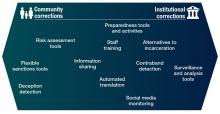The United States has one of the highest incarceration rates in the world: Nearly 1 out of every 100 adults is in prison or jail, and 1 out of every 50 adults is on probation or parole.[1]
The corrections field faces significant challenges. For one, the demographics of those incarcerated have changed in recent years. Today, the U.S. prison population is aging and includes both a greater proportion of women and more individuals with mental health conditions and disabilities.[2] All of these demographic changes strain agencies' ability to deliver services and facilities. The number of people under supervision is also increasing, and community corrections agencies are struggling to provide the level of supervision and immediacy needed to help them successfully re-enter the community. Compounding this is a shift in probation caseloads: Officers who once dealt with relatively low-risk individuals who posed little threat to public safety and had few criminogenic needs now manage higher-risk people who pose a greater threat and may require additional services and increased supervision. Finally, recruiting, training, and retaining corrections staff with the appropriate skills remains extremely difficult.
See "Reducing Mortality in Correctional Facilities"
Technology has the potential to help address these challenges, at least in part. For example, mobile device apps might allow officers to better supervise individuals on parole or probation and enable those under supervision to better access services and programs. Telepresence technology, such as telemedicine and video visitation, could improve health care delivery and increase educational and visitation opportunities for people under supervision.
See "Expediting Pretrial Release Hearings"
NIJ and a team led by the RAND Corporation are collaborating to identify these types of technology needs and innovative solutions for law enforcement, courts, and corrections agencies, as part of the RAND Priority Criminal Justice Needs Initiative. RAND's research team includes RTI International, the University of Denver, and the Police Executive Research Forum. Together, these groups are holistically examining how technology could help not only mitigate staff or facility limitations but also improve training and organizational policies and practices.
The team's approach involves a mixed-method process. The team begins with an extensive literature review on current and emerging challenges in law enforcement, courts, and corrections and on potential solutions to those challenges. It looks at various sources, including existing literature and analysis, research partners' studies, media reports, publications, conference presentations, and surveys and statistical data. Next, the team engages in structured brainstorming with practitioners to further elaborate on challenges and potential solutions. Then, through structured, small-group discussions that use RAND's Delphi method,[3] the team prioritizes the needs and potential solutions.
Researchers, advocacy organizations, manufacturers, and other stakeholders participate in the discussions. But the practitioner is the foundation. Practitioners, such as corrections officers, provide unique insights into how technology can address crime and justice challenges, insights developed from years of dealing with those challenges every day. The team is currently developing a web-based platform that will allow a broader community of practitioners to participate in identifying and prioritizing solutions.
Identifying Corrections Technology Needs
In 2015, RAND published Fostering Innovation in Community and Institutional Corrections: Identifying High-Priority Technology and Other Needs for the U.S. Corrections Sector. This report presents findings and recommendations from the team's initial literature review of challenges and opportunities in the corrections sector. The report also details how a 25-member expert panel prioritized the needs and potential opportunities.[4]
Panel members were divided into two working groups: one for community corrections and one for institutional corrections. Each group worked through a structured needs-generation process that included two sets of facilitated discussions. The first set identified problems and opportunities for corrections, and the second framed the needs that would contribute to addressing each problem.
The panel identified more than 200 needs, then systematically ranked and prioritized them based on each member's assessment of whether the need contributed to accomplishing eight policy goals:
- Facilitating positive behavioral change.
- Protecting the rights of victims/restitution.
- Holding persons convicted of offenses accountable.
- Protecting the public.
- Saving money or time.
- Improving correctional competencies.
- Improving officer and detainee health.
- Reducing officer and detainee injuries.
The resulting set of needs provides a menu of innovative options for addressing key problems or capitalizing on emerging opportunities in corrections.
High-Priority Needs
To help frame the discussion, RAND divided corrections technology and practices into five main categories and multiple subcategories (see Figure 1).
The panel identified 19 high-priority needs for community corrections and 29 for institutional corrections. All of the community corrections needs fall within two categories:
- Information and Communications: These include risk assessment and data collection tools (e.g., tools to effectively detect deception) for both criminal justice–involved individuals and staff. They also include information sharing and data-systems interoperability, informed in part by the need for practitioners and treatment providers to be able to access records for supervision and service delivery.
- Doctrine, Tactics, Management, and Behavioral Knowledge Development and Training: These are related to preparing for natural disasters, guiding the application of risk assessment tools, and developing resources to help officers deal with higher-risk individuals under community supervision. They also include training and resources to help officers better deal with individuals under supervision who have mental health conditions and for selecting and calibrating sanctions for individuals who violate the terms of their sentences.
The 29 institutional corrections needs fall into three categories:
- Facility Operations and Population Services: This includes the use of telepresence technologies for both visitation, to reduce the introduction of contraband into a facility, and medical treatment, to reduce the need to transport incarcerated persons out of secure facilities.
- Information and Communications: These include tracking contacts between detainees and employees and improving surveillance systems to help address contraband.
- Doctrine, Tactics, Management, and Behavioral Knowledge Development and Training: These are related to contraband brought into facilities by staff, staff training on how to address mental health issues of justice-involved individuals, and the jail space management issues resulting from justice reinvestment.
See "How NIJ Is Advancing Technology in Corrections"
Common Needs
The report's authors examined common needs across institutional and community corrections and found that the top-tier needs identified by both working groups included improved risk assessment, emergency preparedness, and training to help staff better manage individuals with mental health issues.
The authors also listed the lower-tier needs from one working group that were described as top-tier needs by the other group:
- Alternative ways to deliver training (virtually or by video, without practitioners having to leave their day-to-day roles).
- Speech-to-speech and text-to-speech translation tools.
- Social media monitoring.
- Alternatives to incarceration, including managing certain groups of incarcerated persons (e.g., the elderly) in nonsecure settings.
- Handheld technologies to detect electronic devices and weapons at a distance.
- Information-sharing technologies.
After examining the common needs across institutional and community corrections, the report's authors proposed several priorities for innovation in corrections (see Figure 2). They also proposed the following five-step agenda for corrections in the United States:
- Develop and improve technology. Corrections needs new technology to meet its specialized needs.
- Adapt technology to corrections. Although some existing technologies can meet corrections needs, tools must address the complexities, sensitivities, and legal concerns of community and institutional settings.
- Perform research and analysis. Some needs identified by both working groups require new knowledge to guide practice.
- Validate tools. There is a clear call to demonstrate that existing tools actually do what they say they do.
- Change organizations' policies and practices. Policymakers and decision-makers can build incentives into grants and other mechanisms to shape behavior, but outside forces can only facilitate — not execute — new innovations.
Technology innovation is not always about the development of new technology. It can also involve improving existing technology, adapting technology from other sectors, or even simply adopting existing technology more broadly or using it more effectively. This innovation agenda represents a starting point for developing a research agenda to transform corrections. Rooted in present problems and current opportunities, the agenda represents a snapshot in time, one that should be revisited both as technology and society change and as it becomes possible to elaborate on and expand the agenda.
Reducing Mortality in Correctional Facilities
According to the Bureau of Justice Statistics, mortality rates in local jails and state prisons have been rising. In 2013, there were 3,479 deaths (including suicides) in prisons — the highest number since data collection began in 2001.[5]
As part of its ongoing corrections work under the Priority Criminal Justice Needs Initiative, the RAND Corporation convened a panel of 16 corrections officials, researchers, and federal partners at its Washington, D.C., office on May 16-17, 2016. The group discussed the challenge of reducing fatalities among staff and detainees from a variety of causes, including homicide, suicide, and death from alcohol or drugs.
NIJ Director Nancy Rodriguez attended the first day of the workshop and spoke with the group about the importance of the Priority Criminal Justice Needs Initiative. She stressed NIJ's commitment to corrections in the Institute's ongoing evaluation of its strategic plan.
Expediting Pretrial Release Hearings
NIJ is exploring the use of video technology in pretrial release hearings. The purpose is to identify protocols that improve practices and maximize return on investment, using videoconferencing to expedite pretrial release hearings for defendants who are being held in jail awaiting trial.
Key considerations include:
- Conducting videoconferences between courtrooms and jails.
- Meeting the needs of defendants, victims, witnesses, jails, and courts.
- Supporting court processes in jail settings, including access to counsel and court interpreters.
- Promoting cost-efficient outcomes, including transportation, security of persons in custody, and pretrial release.
For more information, including a Phase 1 report, visit NIJ's Research on Videoconferencing Pretrial Release Hearings.
For More Information
Learn more about the Priority Criminal Justice Needs Initiative.
About the Author
Jack Harne is a physical scientist in NIJ's Office of Science and Technology.
About This Article
This artice appeared in NIJ Journal Issue 278, May 2017.




